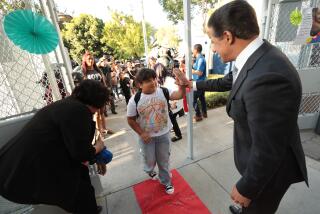Finally, a disturbing trend in education shows signs of reversal

For decades, children of wealthy parents have academically outperformed the kids of poor parents, and better-prepared kindergartners often have more success in high school.
- Share via
For decades, wealthy children have far outperformed poor ones in school, creating a chasm that researchers and advocates say only exacerbates society’s inequalities.
Attempts to improve school readiness and thus close the gap have occupied experts and politicians for years. In 1998, California passed a cigarette tax to fund early childhood education. Hillary Clinton is promising in her presidential campaign universal preschool for 4-year-olds.
When Stanford University’s Sean Reardon, a professor of poverty and inequality in education, decided to check the school readiness gap and how it has changed since the late 1990s, he and his team expected to find that it had widened. After all, income inequality had grown and there had been a recession.
California bill to extend school-choice law faces allegations of inequity »
The results surprised them. From 1998 to 2010, the gap had narrowed — with both poor and wealthy children better prepared for kindergarten and poor students improving their readiness at a faster rate. The gap had shrunk the equivalent, in terms of childhood development, of about one month, and is now at roughly eight months of kindergarten time.
“It’s not a huge change, but it’s more striking because it’s in the opposite direction than we’d seen,” Reardon said. “It’s an important [piece of] evidence that this trend might be reversing.” Racial achievement gaps — between white and black children, as well as between white and Latino children — also have decreased, he said.
Why does it matter? Better-prepared kindergartners often have more success in high school. “The skills that kids have when they enter kindergarten can be very predictive of how they’ll progress through school,” Reardon said. “It’s hard for schools to undo the differences.”
Reardon and his team relied on a massive study conducted by the federal government, which sent staff to about 1,000 kindergartens nationwide to assess children and survey their parents early in the school year in 1998 and again in 2010. The assessors met with kids one on one and asked them questions about words, numbers and colors.
“The pattern of parents increasing their support for learning and similar activities increased overall, but increased more for low-income parents, which is an important finding,” said Hirokazu Yoshikawa, a New York University education professor who focuses on early education.
Reardon’s next step will be to measure why the trend is changing. His team has some theories: more access to preschool, low-income parents reading to their children more, a decrease in exposure to lead, the spreading of the idea that the first few years of a child’s life are crucial to learning.
You can reach Joy Resmovits on Twitter @Joy_Resmovits and by email at [email protected].
ALSO
Chapter 2: ‘I will get you’: How a PTA mom became the target of a revenge campaign
Pediatricians urge states to get tough on parents who don’t want to vaccinate their kids
California bill to extend school-choice law faces allegations of inequity
More to Read
Sign up for Essential California
The most important California stories and recommendations in your inbox every morning.
You may occasionally receive promotional content from the Los Angeles Times.











